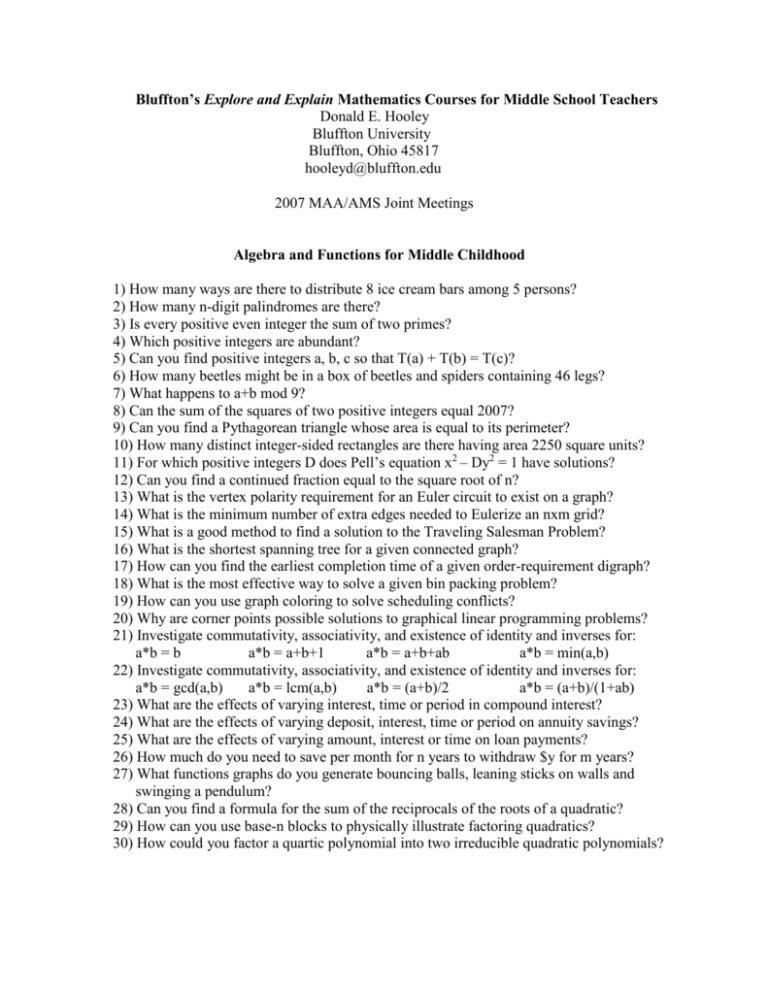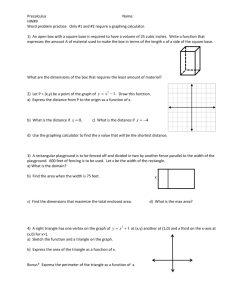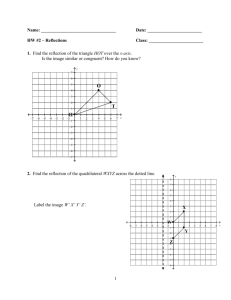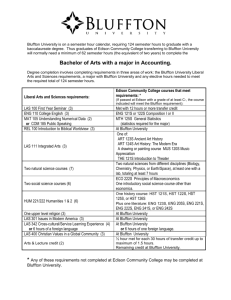Bluffton`s Explore and Explain Mathematics
advertisement

Bluffton’s Explore and Explain Mathematics Courses for Middle School Teachers Donald E. Hooley Bluffton University Bluffton, Ohio 45817 hooleyd@bluffton.edu 2007 MAA/AMS Joint Meetings Algebra and Functions for Middle Childhood 1) How many ways are there to distribute 8 ice cream bars among 5 persons? 2) How many n-digit palindromes are there? 3) Is every positive even integer the sum of two primes? 4) Which positive integers are abundant? 5) Can you find positive integers a, b, c so that T(a) + T(b) = T(c)? 6) How many beetles might be in a box of beetles and spiders containing 46 legs? 7) What happens to a+b mod 9? 8) Can the sum of the squares of two positive integers equal 2007? 9) Can you find a Pythagorean triangle whose area is equal to its perimeter? 10) How many distinct integer-sided rectangles are there having area 2250 square units? 11) For which positive integers D does Pell’s equation x2 – Dy2 = 1 have solutions? 12) Can you find a continued fraction equal to the square root of n? 13) What is the vertex polarity requirement for an Euler circuit to exist on a graph? 14) What is the minimum number of extra edges needed to Eulerize an nxm grid? 15) What is a good method to find a solution to the Traveling Salesman Problem? 16) What is the shortest spanning tree for a given connected graph? 17) How can you find the earliest completion time of a given order-requirement digraph? 18) What is the most effective way to solve a given bin packing problem? 19) How can you use graph coloring to solve scheduling conflicts? 20) Why are corner points possible solutions to graphical linear programming problems? 21) Investigate commutativity, associativity, and existence of identity and inverses for: a*b = b a*b = a+b+1 a*b = a+b+ab a*b = min(a,b) 22) Investigate commutativity, associativity, and existence of identity and inverses for: a*b = gcd(a,b) a*b = lcm(a,b) a*b = (a+b)/2 a*b = (a+b)/(1+ab) 23) What are the effects of varying interest, time or period in compound interest? 24) What are the effects of varying deposit, interest, time or period on annuity savings? 25) What are the effects of varying amount, interest or time on loan payments? 26) How much do you need to save per month for n years to withdraw $y for m years? 27) What functions graphs do you generate bouncing balls, leaning sticks on walls and swinging a pendulum? 28) Can you find a formula for the sum of the reciprocals of the roots of a quadratic? 29) How can you use base-n blocks to physically illustrate factoring quadratics? 30) How could you factor a quartic polynomial into two irreducible quadratic polynomials? Geometry for Middle Childhood 1) What length relationships do you find when constructing midlines of a triangle? 2) What length relationships do you find when constructing medians of a triangle? 3) What shapes are made when midpoints of sides of an arbitrary quadrilateral are connected? 4) What points are equidistant from two given points in Taxicab geometry? 5) How can you use paper folding to illustrate Pythagoreas’ Theorem? 6) What happens when you form sinT/t for each angle T and side t of a triangle? 7) How are the lengths of the sides and the product of the diagonals of a cyclic quadrilateral related? 8) How do the products of the lengths of the segments created by intersecting chords of a circle compare? 9) How do angles inscribed in the same arc of a circle compare to their central angles? 10) How can we estimate the length of a Cevian in a triangle? 11) If Cevians from three vertices of a triangle are concurrent, what relationship holds for the parts in which the sides are divided by these Cevians? 12) What is true about the points of intersection of opposite sides of a hexagon inscribed in any conic section? 13) Where is the point in the interior of an acute triangle which minimizes the sum of the distances from that point to the vertices of the triangle? 14) What are the properties of the 9-Point Circle of a given triangle? 15) What are the vertex angle measures in a regular n-gon? 16) Which regular polygons tesselate the plane? 17) What are possible semi-regular tesselations of the plane? 18) Which polygons are faces of regular polyhedra? 19) What are the axes of symmetry for regular polyhedra? 20) How does area change when dimensions are scaled by a factor of k? 21) How does volume change when dimensions are scaled by a factor of k? 22) What is the symmetry group of a rectangle? 23) What is the symmetry group of a square using only rotations? 24) What is the symmetry group of an equilateral triangle? 25) What are the possible unique combinations of symmetries of a strip pattern? 26) What is the area and perimeter of the Koch snowflake curve? 27) How does the sum of the angles of a triangle on a banana compare to 180 degrees? 28) How is matrix multiplication used to represent reflections, rotations and translations? Credits Kay, David C., College Geometry: A Discovery Approach, 2nd ed., Addison-Wesley Pub. Co., Boston, 2001. Masingilla, Joanna O., and Lester, Frank K., Mathematics for Elementary Teachers via Problem Solving, Prentice-Hall, Inc., Upper Saddle River, NJ, 1998 Otto, Al, personal correspondence, Illinois State University, Normal-Bloomington, IL, 1994. O’Daffer, Phares G., and Clemens, Stanley R., Geometry: An Investigative Approach, 2nd ed., Addison-Wesley Pub. Co., Reading, MA, 1992.







